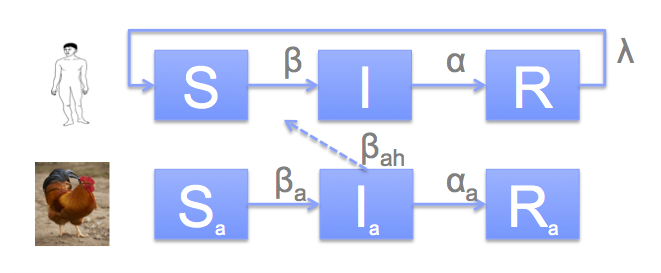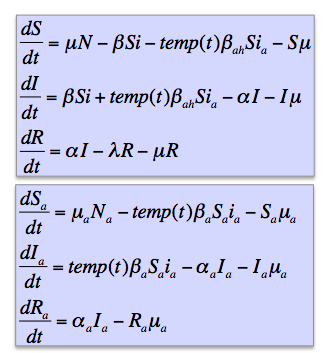Notice: this Wiki will be going read only early in 2024 and edits will no longer be possible. Please see: https://gitlab.eclipse.org/eclipsefdn/helpdesk/-/wikis/Wiki-shutdown-plan for the plan.
Difference between revisions of "STEM Avian Influenza Model"
(New page: '''[http://wiki.eclipse.org/Available_Models Back to Available Models]''' ==Background== Several outbreaks of avian influenza has occurred in the past, including the SARS outbreak in 200...) |
|||
| Line 3: | Line 3: | ||
==Background== | ==Background== | ||
| − | Several outbreaks of avian influenza has occurred in the past, including the SARS outbreak in 2002, H5N1 in 1997 and H7N9 in 2013 -- all originating in China. This STEM model captures the transmission of the virus between (domesticated) birds, from birds to humans (e.g. at market places) and optionally human-to-human. | + | Several outbreaks of avian influenza has occurred in the past, including the SARS outbreak in 2002, H5N1 in 1997 and H7N9 in 2013 -- all originating in China. This STEM model captures the transmission of the virus between (domesticated) birds, from birds to humans (e.g. at market places) and optionally human-to-human. Mixing of infectious birds between neighboring regions is controlled using a separate parameter from the human mixing parameter. |
| − | + | ||
==Model== | ==Model== | ||
| Line 11: | Line 10: | ||
[[Image:STEM_AvianFluModel.JPG]] | [[Image:STEM_AvianFluModel.JPG]] | ||
| − | |||
Below are the differential equations that explain the rate change in the system. Sets 1-4 represent the rate change in the cohorts 0-3. | Below are the differential equations that explain the rate change in the system. Sets 1-4 represent the rate change in the cohorts 0-3. | ||
[[Image:STEM_AvianFluModel_Diff_Eq.JPG]] | [[Image:STEM_AvianFluModel_Diff_Eq.JPG]] | ||
Revision as of 13:58, 22 August 2013
Background
Several outbreaks of avian influenza has occurred in the past, including the SARS outbreak in 2002, H5N1 in 1997 and H7N9 in 2013 -- all originating in China. This STEM model captures the transmission of the virus between (domesticated) birds, from birds to humans (e.g. at market places) and optionally human-to-human. Mixing of infectious birds between neighboring regions is controlled using a separate parameter from the human mixing parameter.
Model
The model is captured using an SIR model for humans as well as birds, as well as an indirect transmission pathway between infected birds and susceptible humans:
Below are the differential equations that explain the rate change in the system. Sets 1-4 represent the rate change in the cohorts 0-3.


